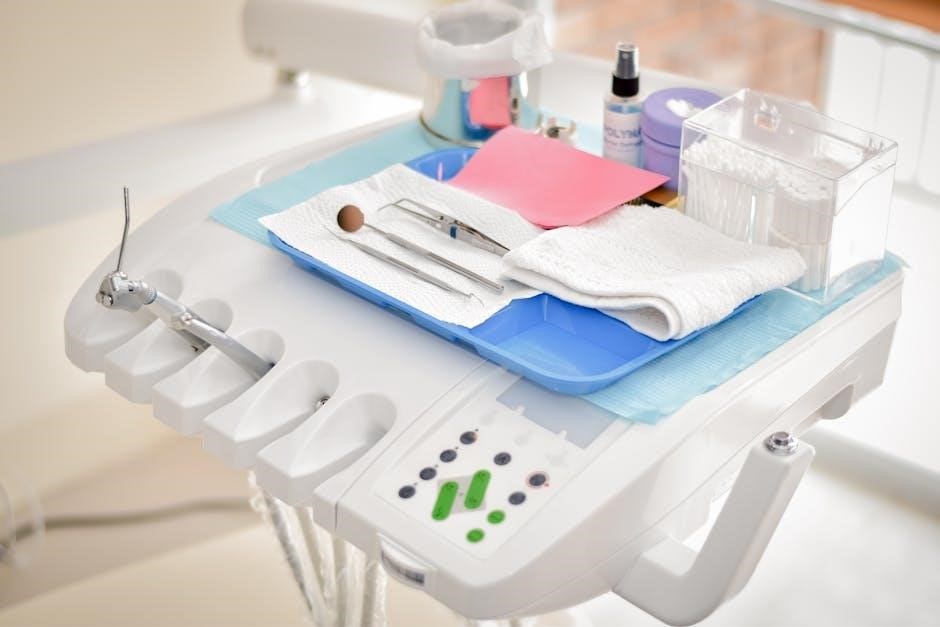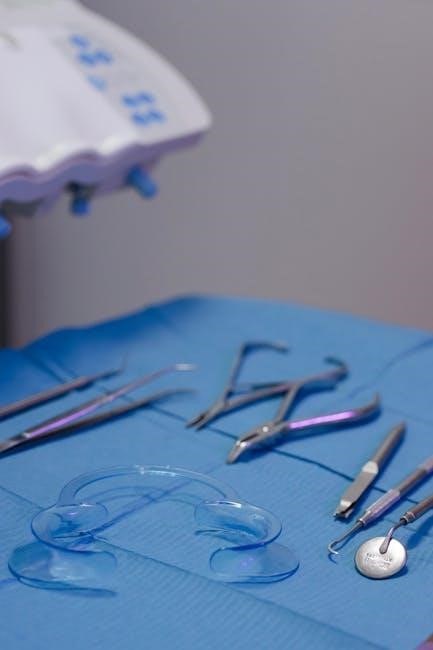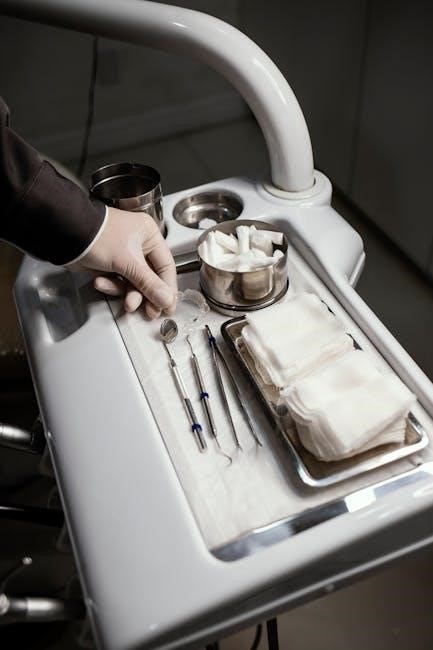Dental Assistant Tray Set Up Guide
This guide provides dental assistants with step-by-step instructions for effective tray preparation. Proper set-up optimizes workflow, ensures instrument readiness, and supports efficient dental procedures. Mastering tray preparation is vital for successful assistance.
Importance of Proper Tray Set-Up
Proper dental tray set-up is paramount in modern dentistry, directly impacting efficiency and patient care. A well-organized tray minimizes chair time, streamlining procedures and allowing the dentist to focus on the patient. Following the basic dental tray set-up ensures all necessary instruments are readily available, reducing delays and promoting a smooth workflow.
Efficient four-handed dentistry relies heavily on the dental assistant’s ability to anticipate the dentist’s needs. A meticulously prepared tray, including items like 2×2 gauze, cotton rolls, and the air-water syringe tip, enhances teamwork and reduces stress during procedures. Moreover, proper sterilization and arrangement contribute to a safe and comfortable environment for the patient. Prioritizing proper tray set-up is, therefore, an integral aspect of quality dental care.
Duration of Dental Tray Set-Up
Typically, the dental tray set-up process takes approximately 5 to 10 minutes. This time is allocated to gathering the necessary supplies, ensuring sterilization protocols are followed meticulously, and arranging the instruments on the tray in an organized manner. The duration can fluctuate based on the complexity of the procedure.
For instance, setting up a tray for a routine check-up might be quicker compared to preparing a tray for a more intricate procedure like a root canal. Efficient dental assistants aim to optimize this process through familiarity with instruments and standardized set-up protocols. The goal is to minimize the time spent on preparation without compromising accuracy or sterilization, which can impact the patient’s comfort.

Basic Tray Components
A basic dental tray typically includes a mouth mirror, explorer, and cotton pliers. These instruments are essential for initial examination and material handling during various dental procedures.
Mouth Mirror
The mouth mirror is a fundamental instrument in dentistry, serving multiple critical functions during examination and treatment. Primarily, it provides indirect vision, allowing the dentist or assistant to view areas of the mouth that are otherwise difficult to see directly. This is particularly useful for examining posterior teeth and other hard-to-reach areas.
Additionally, the mouth mirror is used for retraction, gently holding back the tongue, cheek, or lip to provide a clear field of view. This is essential for procedures requiring precision and visibility. The mirror also reflects light into the oral cavity, enhancing illumination and improving the dentist’s ability to identify subtle details. Furthermore, it aids in transillumination when the dentist is trying to identify cracks in teeth. Proper handling and placement of the mouth mirror are crucial for effective dental procedures.
Explorer
The explorer, a slender instrument with a sharp, pointed tip, is crucial for tactile examination of tooth surfaces. It helps detect subtle irregularities, such as calculus, decay, or defects in enamel. The explorer’s fine tip allows clinicians to differentiate between smooth, healthy tooth structure and rough or altered surfaces indicative of dental issues.
Dentists and dental hygienists use the explorer to assess the depth and extent of caries, evaluate the margins of restorations, and identify areas of demineralization. By carefully running the explorer along the tooth surface, clinicians can feel changes in texture or hardness that may not be visible to the naked eye. Different types of explorers exist, each designed for specific purposes, like examining pits and fissures or assessing periodontal pockets. Proper technique and gentle pressure are essential when using an explorer to avoid damaging tooth structure or causing discomfort to the patient. Thorough sterilization of explorers is paramount to prevent cross-contamination.
Cotton Pliers
Cotton pliers, also known as dressing pliers, are essential instruments used for grasping and transferring small items within the oral cavity. Their primary function is to pick up, place, and retrieve cotton rolls, gauze squares, and other materials during dental procedures. These pliers feature a slender design with pointed or serrated tips that provide a secure grip without causing trauma to delicate tissues.
Dental assistants frequently use cotton pliers to deliver medicaments, apply topical anesthetics, or remove debris from the operative field. The instrument’s precise control allows for accurate placement of materials in hard-to-reach areas. Cotton pliers come in various sizes and designs, including locking and non-locking versions, to accommodate different clinical needs. Proper handling and sterilization protocols are crucial to maintain the integrity and safety of these versatile instruments. Regularly inspecting the tips for wear or damage is essential to ensure optimal performance and patient safety.

Essential Instruments & Supplies
Beyond the basic set, other instruments and supplies are crucial. These include gauze, cotton rolls, suction tips, and syringe tips. Each item plays a vital role in maintaining a clean and efficient workspace.
2×2 Gauze and Cotton Rolls
2×2 gauze squares and cotton rolls are indispensable for a multitude of dental procedures. Their primary function revolves around controlling moisture and maintaining a clear field of operation for the dentist. Gauze squares are excellent for absorbing excess saliva, blood, or irrigants during procedures like extractions or restorations. They can also be used to apply topical medications or disinfectants to the treatment area.
Cotton rolls, on the other hand, are typically employed to isolate specific teeth or areas of the mouth. This isolation is crucial during bonding procedures, sealant applications, or when placing fillings. Different sizes of cotton rolls may be used depending on the tooth and location. Both 2×2 gauze and cotton rolls should be readily accessible on the dental tray, ensuring the dental assistant can quickly provide them to the dentist as needed, contributing to a streamlined and efficient dental appointment.
Saliva Ejector and HVE Tip
The saliva ejector and High-Volume Evacuator (HVE) tip are essential components of the dental assistant’s armamentarium for effective moisture control. The saliva ejector is a low-volume suction device used to continuously remove saliva and other fluids from the patient’s mouth, ensuring patient comfort and maintaining a clear operating field. Its gentle suction is ideal for longer procedures or for patients who produce excess saliva.
Conversely, the HVE tip is a high-powered suction device designed to rapidly remove large volumes of fluid, debris, and aerosols generated during procedures such as drilling or ultrasonic scaling. Proper placement of the HVE tip is crucial to minimize aerosol production, protecting both the patient and dental team from potentially infectious particles. Both the saliva ejector and HVE tip are strategically placed on the dental tray for immediate access, allowing the assistant to quickly adapt to the dentist’s needs and maintain optimal visibility throughout the procedure.
Air-Water Syringe Tip
The air-water syringe tip is an indispensable tool for the dental assistant, serving multiple critical functions during various dental procedures. This versatile instrument delivers a controlled stream of air, water, or a combination of both, providing the dentist with enhanced visibility and control within the oral cavity. The air stream is used to dry the operative field, ensuring optimal conditions for bonding agents and restorative materials. Water rinses away debris, such as tooth fragments or polishing paste, maintaining a clear view of the treatment area.
The combined air-water spray helps to remove excess material, improving accuracy during procedures. The assistant must ensure the syringe tip is securely attached to the air-water syringe and that the air and water streams are functioning properly before the procedure begins. Easy access to the air-water syringe tip on the dental tray is crucial for efficient and effective assistance, contributing to a smooth and successful dental appointment.

Dental Dam Set-Up
Dental dam set-up is critical for isolation during procedures. It involves specific materials like the dam, clamp, forceps, frame, punch, and napkin. Proper assembly ensures a sterile and dry operating field.
Dental Dam Clamp and Forceps
Dental dam clamps are essential for securing the dental dam around a specific tooth, providing isolation during procedures. These clamps come in various shapes and sizes to accommodate different tooth morphologies and positions within the arch. Selecting the appropriate clamp is crucial for stability and preventing damage to the surrounding tissues.
Dental dam forceps are specifically designed to grasp and expand the dental dam clamp, allowing for its placement and removal from the tooth. The forceps feature a locking mechanism that securely holds the clamp during manipulation. Proper technique and careful handling of the forceps are necessary to ensure efficient and atraumatic clamp placement, contributing to a successful dental dam isolation.
Dental Dam Material and Punch
The dental dam material, typically made of latex or a latex-free alternative, provides a barrier to isolate the operating field from the oral environment. This material is available in various sizes, thicknesses, and colors to suit different clinical situations. Proper selection and handling of the dental dam material are vital to maintain a dry and aseptic working area.
The dental dam punch is used to create precise holes in the dental dam material, corresponding to the teeth that need isolation. The punch features a rotating disc with different sized punches to accommodate variations in tooth size. Accurate placement of the holes is critical for effective isolation, preventing leakage of saliva and other fluids into the operating field.
Dental Dam Frame and Napkin
The dental dam frame provides support and tension to the dental dam material, ensuring a clear and unobstructed view of the operating field. Frames are available in various shapes and sizes, typically made of metal or plastic. The frame stretches the dam, creating a secure barrier around the isolated tooth or teeth, which is essential for maintaining a dry field.
A dental dam napkin, placed between the dam and the patient’s face, enhances comfort and absorbs any moisture accumulating under the dam. This disposable napkin is usually made of soft, absorbent material, preventing skin irritation and improving patient tolerance. Proper placement of the napkin contributes to a more comfortable and successful dental dam application.

Tray Set-Up Tips
Efficient tray setups require instrument knowledge and strategic arrangement. Prioritize ergonomics, anticipate the dentist’s needs, and maintain a sterile field. These tips will enhance your efficiency and support seamless procedures.
Instrument Knowledge
A dental assistant’s proficiency hinges on a comprehensive understanding of dental instruments. Knowing each instrument’s name, purpose, and proper handling is paramount. This knowledge enables assistants to anticipate the dentist’s needs, ensuring smooth and efficient procedures. Familiarity with instruments minimizes errors and reduces chair time, contributing to a more productive environment.
Understanding instrument variations, such as different sizes and designs, is equally important. Recognizing subtle differences allows for precise instrument selection, optimizing patient care. Regular review and hands-on practice reinforce instrument knowledge, building confidence and competence. Mastering this fundamental skill elevates the dental assistant’s role, fostering teamwork and enhancing overall dental practice efficiency.
Instrument Arrangement
Strategic instrument arrangement on the dental tray is crucial for efficiency. Instruments should be organized logically, typically from left to right, based on their sequence of use during a procedure. This arrangement allows the dentist to easily access the necessary tools without disrupting the workflow.
Prioritize frequently used instruments, placing them within immediate reach. Group instruments with similar functions together for quick identification. Maintaining a clean and uncluttered tray reduces the risk of errors and enhances safety. Consider the dentist’s preferences when arranging instruments, as individual techniques may vary. Consistency in arrangement across procedures minimizes confusion and promotes a streamlined workflow, optimizing chair time and patient care.






